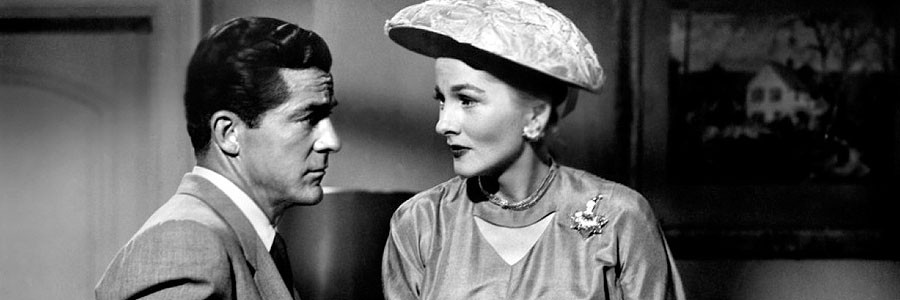
Beyond A Reasonable Doubt

BEYOND A REASONABLE DOUBT (MOVIE)
RKO Radio Pictures Inc.
Original release: September 5th, 1956
Running time: 80 minutes
Director: Fritz Lang
Writer: Douglas Morrow
Cast: Dana Andrews, Joan Fontaine, Sidney Blackmer, Philip Bourneuf, Barbara Nichols

Film noir and Fritz Lang are two irresistible combinations for any aficionados of film. On the one hand we have a genre that’s characterised by its crime stories, morally dubious protagonists and the overall mood it exudes with its darkened alleys, hushed conversations and secret rendezvous’.
On the other hand we have a prolific director who rose to acclaim during the Weimar Republic with one of the era’s most iconic Expressionist films, Metropolis (1927).
Having fled Germany during the rise of Nazism, Lang worked in Paris for a few years before moving to Hollywood where he made many more films including Man Hunt (1941), Scarlet Street (1944) and While the City Sleeps (1956), as well as this one, Beyond A Reasonable Doubt, each fused with that unmistakable look and/or feel of film noir.
Beyond A Reasonable Doubt’s story is an intriguing one and doesn’t waste any time. It’s only got 80 minutes so it sets its plot out in the first few minutes and lets us see how it unfolds.
When a nightclub dancer is a found dead, Austin Spencer (Sidney Blackmer) a newspaper publisher, wants to demonstrate a problem with the legal system; that innocent men can be given the death penalty based only on circumstantial evidence. He ends up persuading his soon-to-be son-in-law Tom Garrett (Dana Andrews) to help him with an elaborate experiment.

By planting circumstantial evidence they implicate Tom in the murder of the nightclub dancer, hoping to get him convicted for the crime. As the case goes to court, Tom is found guilty and sentenced and it looks as if their plan to highlight this legal rpoblem and humiliate DA Roy Thompson (Philip Bourneuf) has almost succeeded. The only thing left is for Austin to reveal that it was all a set-up and thus clear Tom of all charges, but then the unthinkable happens (at least for Tom) and Beyond A Reasonable Doubt begins to take some surprising turns before arriving at a shocking conclusion.
With his fiancée, Susan Spencer (Joan Fontaine), fighting to clear his name despite incriminating evidence, one small slip reveals something she could never have guessed about Tom.
As a male melodrama Beyond A Reasonable Doubt works incredibly well. We’re drawn into a story and like the title suggests, we believe Tom to be innocent of all charges. Yet there’s a nagging moral ambiguity it all, which is also present in While The City Sleeps. Geoff Mayer and Brian McDonnell compare them both in Encyclopedia of Film Noir:
In both films the protagonists struggle against the malign forces of corruption, violence, and greed that seem to pervade society but the way in which justice is delivered at the end is something unique to Beyond A Reasonable Doubt and Lang’s extensive and diverse repertoire.
As we’re left reeling from the events which have unfolded, we’re also asking “Could he really have done it?” Tom doesn’t seem to fit the standard profile of a killer that we usually see in movies, there’s nothing about him that indicates such a nature, but that’s what makes it so effective.
- Mayer, G. and McDonnell, B. Encyclopedia of Film Noir (2007), Greenwood Press
It’s a rare surprise in cinema and Lang adds an edge of darkness, not in what we would judge in its aesthetic, but in the underbelly of it protagonist.
What we’ve come to know as film noir today couldn’t have been shaped without Lang or indeed without Beyond A Reasonable Doubt. While it might not have the look of those other noirs, it casts its own brilliant shadow, beyond any doubt.

Patrick Samuel
The founder of Static Mass Emporium and one of its Editors in Chief is an emerging artist with a philosophy degree, working primarily with pastels and graphite pencils, but he also enjoys experimenting with water colours, acrylics, glass and oil paints.
Being on the autistic spectrum with Asperger’s Syndrome, he is stimulated by bold, contrasting colours, intricate details, multiple textures, and varying shades of light and dark. Patrick's work extends to sound and video, and when not drawing or painting, he can be found working on projects he shares online with his followers.
Patrick returned to drawing and painting after a prolonged break in December 2016 as part of his daily art therapy, and is now making the transition to being a full-time artist. As a spokesperson for autism awareness, he also gives talks and presentations on the benefits of creative therapy.
Static Mass is where he lives his passion for film and writing about it. A fan of film classics, documentaries and science fiction, Patrick prefers films with an impeccable way of storytelling that reflect on the human condition.
© 2022 STATIC MASS EMPORIUM . All Rights Reserved. Powered by METATEMPUS | creative.timeless.personal. | DISCLAIMER, TERMS & CONDITIONS
HOME | ABOUT | CONTACT | TWITTER | GOOGLE+ | FACEBOOK | TUMBLR | YOUTUBE | RSS FEED
CINEMA REVIEWS | BLU-RAY & DVD | THE EMPORIUM | DOCUMENTARIES | WORLD CINEMA | CULT MOVIES | INDIAN CINEMA | EARLY CINEMA
MOVIE CLASSICS | DECONSTRUCTING CINEMA | SOUNDTRACKS | INTERVIEWS | THE DIRECTOR’S CHAIR | JAPANESE CINEMA





